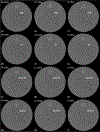Efficient Evaluation of Low-contrast Detectability of Deep-CNN-based CT Reconstruction Using Channelized Hotelling Observer on the ACR Accreditation Phantom
- PMID: 35813246
- PMCID: PMC9262078
- DOI: 10.1117/12.2612414
Efficient Evaluation of Low-contrast Detectability of Deep-CNN-based CT Reconstruction Using Channelized Hotelling Observer on the ACR Accreditation Phantom
Abstract
As deep-learning-based denoising and reconstruction methods are gaining more popularity in clinical CT, it is of vital importance that these new algorithms undergo rigorous and objective image quality assessment beyond traditional metrics to ensure diagnostic information is not sacrificed. Channelized Hotelling observer (CHO), which has been shown to be well correlated with human observer performance in many clinical CT tasks, has a great potential to become the method of choice for objective image quality assessment for these non-linear methods. However, practical use of CHO beyond research labs have been quite limited, mostly due to the strict requirement on a large number of repeated scans to ensure sufficient accuracy and precision in CHO computation and the lack of efficient and widely acceptable phantom-based method. In our previous work, we developed an efficient CHO model observer for accurate and precise measurement of low-contrast detectability with only 1-3 repeated scans on the most widely used ACR accreditation phantom. In this work, we applied this optimized CHO model observer to evaluating the low-contrast detectability of a deep learning-based reconstruction (DLIR) equipped on a GE Revolution scanner. The commercially available DLIR reconstruction method showed consistent increase in low-contrast detectability over the FBP and the IR method at routine dose levels, which suggests potential dose reduction to the FBP reconstruction by up to 27.5%.
Keywords: Image quality assessment; channelized Hotelling observer (CHO); protocol optimization; radiation dose reduction.
Figures



References
-
- Mileto A, et al., State of the Art in Abdominal CT: The Limits of Iterative Reconstruction Algorithms. Radiology, 2019. 293(3): p. 491–503. - PubMed
-
- Jensen CT, et al., Image quality assessment of abdominal CT by use of new deep learning image reconstruction: initial experience. American Journal of Roentgenology, 2020. 215(1): p. 50–57. - PubMed
-
- Greffier J, et al., Image quality and dose reduction opportunity of deep learning image reconstruction algorithm for CT: a phantom study. European radiology, 2020. 30(7): p. 3951–3959. - PubMed
-
- Racine D, et al., Image texture, low contrast liver lesion detectability and impact on dose: deep learning algorithm compared to partial model-based iterative reconstruction. European Journal of Radiology, 2021: p. 109808. - PubMed
Grants and funding
LinkOut - more resources
Full Text Sources
Research Materials
Miscellaneous
